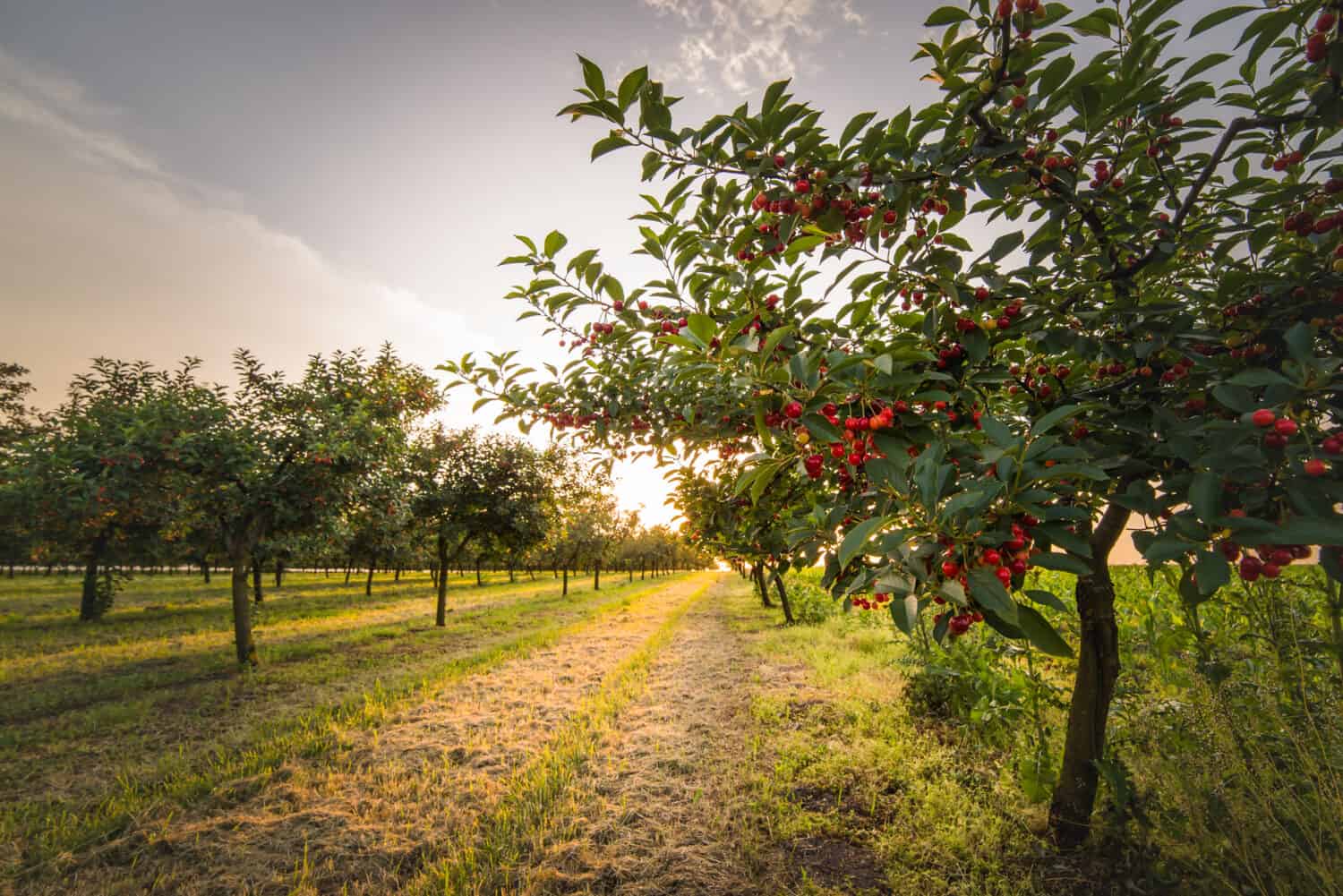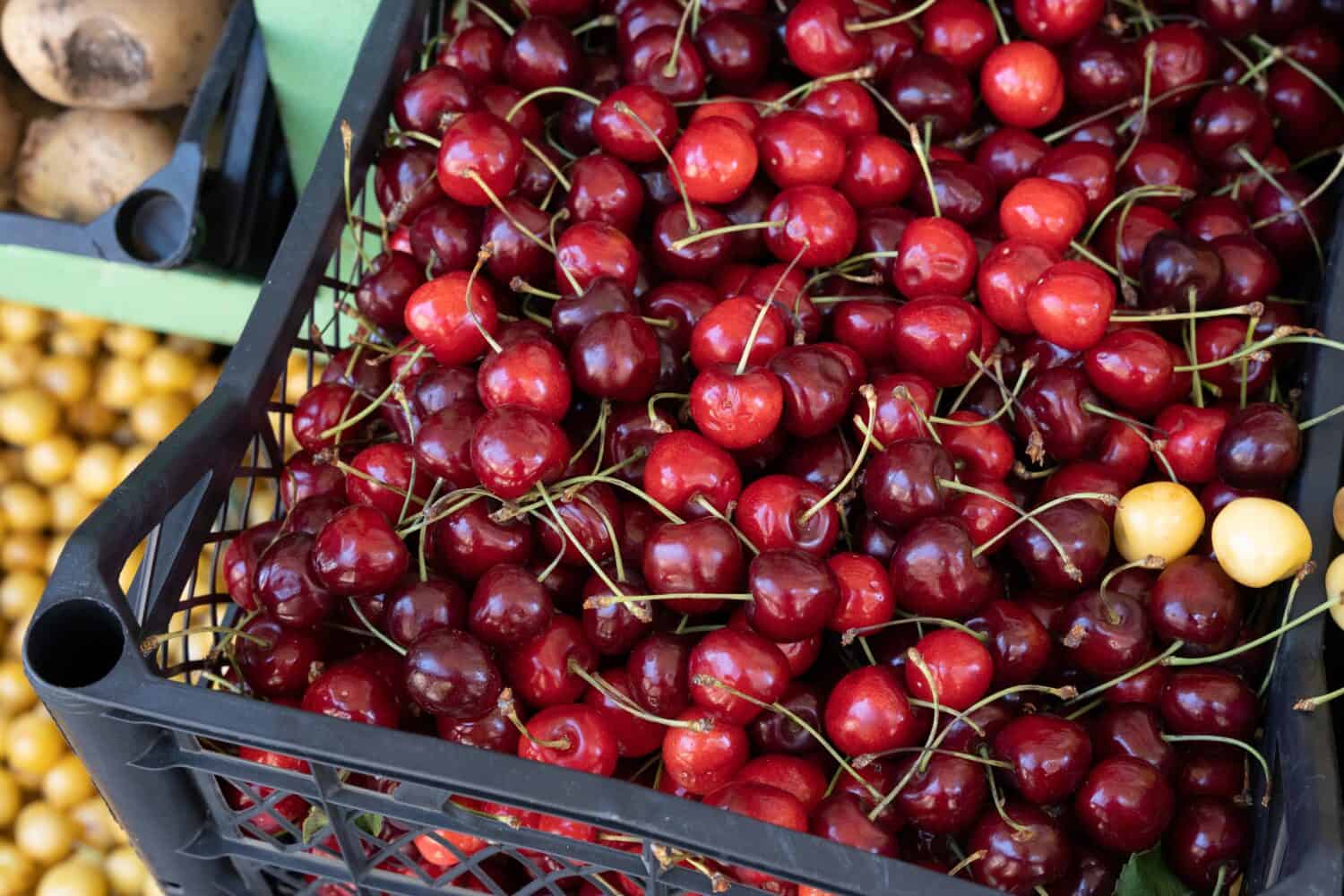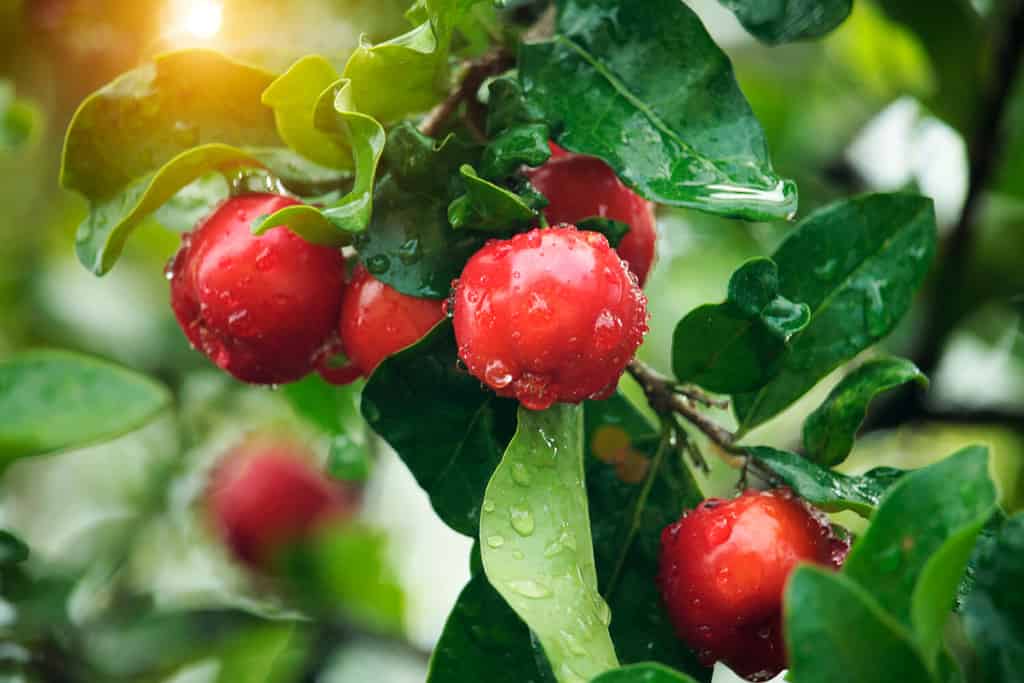Summer is upon us. And that means the fresh fruit selection is the best of the year. There are a few specific fruits that are quintessential of the summer season. That list includes cherries, a delightfully sweet treat that is best in peak season. However, there are a handful of primary growing regions, and the peak season will differ slightly with each one. So we pulled together a guide to help you learn when cherries are in peak season throughout the U.SS.
Pacific Northwest
The Pacific Northwest is known for its cherry production. Washington and Oregon are two of the nation’s top cherry-producing states. These two states grow roughly 90% of the nation’s sweet cherry supply. The region’s moderate climate, with cool winters and warm summers, provides an ideal environment for cherry trees to thrive. The two main types of cherries from this region are sweet Bing cherries and tangy Rainier cherries.
Sweet Bing cherries have a deep red to almost black color and juicy flesh. They are the most widely cultivated cherry variety in the Pacific Northwest. They offer a classic cherry flavor that is both sweet and slightly tart.
Rainier cherries, named after Mount Rainier, are a crossbreed. They have yellow or golden skin with a bright red blush. Their flesh is exceptionally sweet, delicate, and low in acidity, making them a prized delicacy. The arrival of these slightly larger cherries is highly anticipated every year.
Peak Season
Cherries in the Pacific Northwest are usually in peak season from early June to early August. Bing cherries usually ripen earlier. They start to hit store shelves from early to mid-June (depending on the annual weather patterns). Rainier cherries follow suit in July and are only available for two months.

Rainier cherries have a unique color, a bright flavor, and are extremely popular.
©patjo/Shutterstock.com
California
California is known for its abundant agricultural production. Part of that yield is an abundance of cherries. The state produces some exceptional varieties, including Bing, Brooks, Chelan™, Tulare, Rainier, and Coral.
Brooks cherries are larger and firm. They have a deep red color and a sweet flavor. The University of California developed this as a more heat-tolerant variety.
Tulare cherries have a dark red color, crisp texture, and rich, sweet taste. However, they are not as firm as Bing cherries.
Coral cherries have bright red skin and a very sweet flavor. They have lower acidity than some of their relatives and typically run closer to very large.
Chelan™ cherries are mild, firmer than Bing cherries and have a slightly tarter flavor. They have an almost mahogany coloring, which makes them stand out.
Peak Season
If you are anxiously awaiting cherry season, there’s some good news. The sweet fruits grown in California hit stores slightly earlier in the year. Their cherry season typically begins mid-April to early May and lasts through early June. However, the exact timing may vary depending on the specific microclimate and growing conditions within different parts of the state. They have a shorter growing season, but the cherries are certainly worth it.

California grows a large variety of cherries, but the state has a very short growing season. So, get them while you can!
©veeterzy/Shutterstock.com
Michigan
Michigan has a long-standing tradition of cherry cultivation. The state’s unique geography, bordered by the Great Lakes, creates a fantastic climate for cherries. Tart cherries make up the largest part of cherry production in Michigan. These varieties get mostly used in pie fillings and other baked goods. They also get canned, dried, and turned into cherry juices for year-round enjoyment.
The most prevalent tart cherry variety in Michigan is the Montmorency. They are bright red and have a slightly acidic and tangy flavor. They are perfect for culinary applications and provide a unique tartness that complements sweet dishes.
Another tart variety grown in the region is Balaton cherries. These Hungarian sour cherries are dark red and slightly sweeter than Montmorency cherries.
Peak Season
Michigan’s cherry harvest typically begins in late June and lasts through August.

Michigan produces the majority of tart or sour cherries sold in the United States.
©Amelia Martin/Shutterstock.com
New York
New York is home to several cherry-growing regions, particularly in the western part of the state. The climate in this region offers suitable conditions for cherries to thrive, which results in significant cherry production. Locals enjoy the benefit of many U-Pick orchards in the state to get their fill of sweet and tart cherries. Some sweet types can grow in the state, though they do not achieve the same level of sweetness. Montmorency cherries, however, are very cold-hardy and do well in the east coast state.
Peak Season
Cherry season in New York usually starts in late June and extends through July. However, the exact timing may vary slightly based on the specific location and weather conditions.

New York state has lots of cherry orchards for residents to visit and pick some tasty fruit right off the trees.
©Fotokostic/Shutterstock.com
Colorado
Residents of Colorado look forward to their local cherry season every year. Much like the Pacific Northwest, California, and Michigan, the state boasts plenty of roadside stands selling goods made from their local cherry harvest.
The Western slope successfully grows sweet cherry varieties. These make their way to farmer’s markets throughout the state, and many cherry orchards offer U-Pick options. Additionally, sour or tart cherries grow well throughout the state since they are more cold-hardy.
Peak Season
The highly anticipated Colorado cherry season starts in late June and runs through late July. Crops grown on the Western slope have a more reliable growing season, while the season in other parts of the state may vary based on weather.

Farmer’s markets are a popular place to pick up fresh cherries every summer. They come straight from the orchards, so the fruit is as fresh as can be.
©RolandsBoss/Shutterstock.com
Cherry Facts
Cherry Varieties
Most of us are familiar with sweet cherries (Prunus avium) and tart or sour cherries (Prunus cerasus). They, and over 1,000 other cherrU.S.rieties in the U.S., belong to the Rosaceae family. These small, round stone fruits boast firm and juicy flesh. Cherries come in a range of colors, including shades of red, yellow, and black. Each one has a unique flavor profile and is suitable for specific applications.
Sweet cherries, such as Bing and Brooks varieties, contain a high sugar content. They are perfect for enjoying fresh, adding to salads, or adding to a wide array of fresh desserts.
Tart cherries, like Montmorency and Balaton, have lower sugar levels and offer a pleasant tartness that brings a delightful zing to pies, preserves, and other culinary creations. They are the most common variety to add to various baked goods, as their tart flavor can get offset by the sugar in a recipe.
Cherry Health Benefits
Besides their delicious taste, cherries offer several health benefits. They are rich in antioxidants, including anthocyanins, which provide anti-inflammatory and immune-boosting properties. Cherries also contain important vitamins and minerals, including vitamin C, calcium, magnesium, choline, iron, manganese, copper, and potassium. Their high fiber content aids digestion. Cherries are so nutrient-rich they easily fall into the superfood category. So you can feel good about enjoying in the tasty treats every summer.
When selecting cherries, opt for plump, firm, and glossy fruit. Avoid cherries that appear soft, bruised, or have wrinkled skin. The stem should be green and attached to the fruit, though they sometimes fall off during processing, packing, and shipping. If possible, sample a cherry to determine your ideal level of sweetness or tartness. Store your fruit in a perforated bag or container in the refrigerator to maintain its freshness. This step helps extend their shelf life and ensures they retain their flavor and texture for longer.

Cherries are so nutrient-rich they easily fall into the superfood category!
©Mr.Somchai Sukkasem/Shutterstock.com
Thank you for reading! Have some feedback for us? Contact the AZ Animals editorial team.







